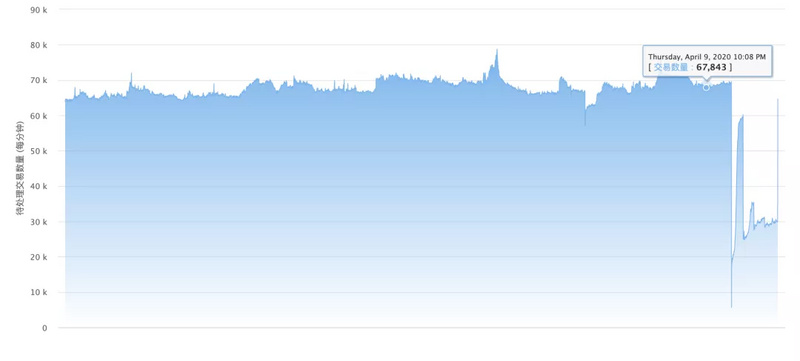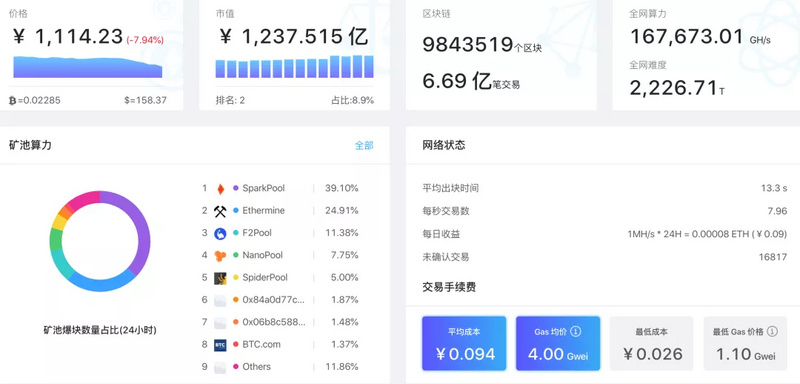Popular Science | How is the Ethereum block size determined
Author: NEST lovers _CryptoV12
With the development of the blockchain industry, the ecosystem built on the Ethereum network is getting larger and larger. In addition to satisfying the transaction packaging of various assets issued based on the Ethereum network, it also needs to meet the packaging of various smart contracts Transactions, such as DeFi protocol ( Uniswap ), oracle protocol ( NEST Protocol ), games ( Decentraland ) and other related business contracts. This makes the Ethereum network need to process more and more transactions, so that when the market fluctuates, we often see Ethereum congestion and miner fees increase significantly.

EthGasStation: Ethereum network GAS fee consumption ranking
- The crisis under the iceberg: DeFi financial crisis and challenges
- Data: Demand for Bitcoin from institutional and retail customers explodes
- Blockchain empowerment, charging pile accelerates new infrastructure
According to the natural growth rate of the current state of the Ethereum blockchain, it will not be long before the Ethereum network will face some problems. Because, with the continuous growth of Ethereum block data, our threshold for running Ethereum full nodes will become higher and higher, which will cause the Ethereum network to become more centralized. (Currently running an Ethereum node requires approximately 220GB of storage space)
As the network delay increases, its speed may become slower and slower; with the emergence of "state inflation" , block verification may become more difficult. Eventually, as the transaction TPS reaches the upper limit and the client improvement is more difficult to achieve, both Ethereum end users and core developers will be hit hard, which will affect the sustainable development of the Ethereum ecosystem.

Figure 2. Etherscan: the number of transactions to be packaged per day on the Ethereum network
At a macro level, the problem the Ethereum 1.0 network is facing is that the Ethereum blockchain is getting bigger and bigger! Looking at the breakdown, the variables that make the problem more prominent are the three factors that affect data storage, transaction status, and block size . Today, we mainly analyze the core factor of "Ethereum block size" , and specifically understand how the block size of the Ethereum network is determined.
Unlike the Bitcoin network, Ethereum does not explicitly limit the size of each block by memory, but instead enforces the size of each block through the block GasLimit.
The Ethereum block GasLimit setting effectively limits the amount of transactions that can be packaged in a block. The GasLimit parameter is determined collectively by Ethereum miners, that is, the value of GasLimit is dynamically increased or decreased by voting. The most recent vote was in the second half of 2019, and the miners voted to increase the GasLimit of Ethereum from the original 8 million Gas units to 10 million, which increased the size of each block by 25% compared to the previous block. Left and right, this theoretically improves the TPS of the Ethereum network.

Figure 3: BTC.COM shows that the Ethereum network TPS: 8 ~ 14
Increasing the upper limit of the GasLimit of a block means that the data volume of a single block's package transaction is increased, and the block becomes larger, which in turn makes the information propagation speed slower, which will lead to an increase in the probability of the uncle block. Even Ethereum Uncle Block has some ETH mining rewards, but miners do not want to encounter it. Therefore, there is a check and balance relationship between the upper limit of GasLimit of a single block and the miner group. (Note: In the Ethereum system, if at the same block height, multiple miners have dug out new blocks, one of these blocks will become the block on the longest chain, while the other blocks, If it is referenced by subsequent blocks, it will be called Uncle Block)
Therefore, the GasLimit of a single block of the Ethereum network cannot be promptly prompted in a short time, but should be dynamically adjusted according to the development status of the Ethereum network to balance the efficiency required for ecological development and the interests of the miner community.
So far, there is a scientific conclusion about the "safe" block size cap data, but we generally believe that the increase in TPS caused by raising the GasLimit cap of a single block is not enough to achieve the development of Ethereum in the next 3 years. In addition, there are many other related problems.

Finally, looking forward to the early arrival of ETH 2.0!
We will continue to update Blocking; if you have any questions or suggestions, please contact us!
Was this article helpful?
93 out of 132 found this helpful
Related articles
- Bybit Airdrop Gifts are available for a limited time! Teach you how to receive 1632 USDT in 10 minutes!
- After halving, the cost of Shuanghua BCH and BSV is less than US $ 10,000? There are two major misunderstandings
- The MOV Federation Node is officially unveiled, and the original team revealed the destruction plan
- From the halving prediction of BCH and BSV, will BTC enter a decline phase?
- Crisis before the midday diving has emerged, analysts say the test has just begun
- Introduction | What support does ETH 1.0 need to provide for ETH 2.0?
- QKL123 market analysis | The market has fallen, is it unfavorable to halve? (0410)






